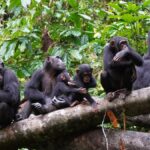Table of Contents
Introduction:
Chimpanzees, our closest living relatives in the animal kingdom, have long fascinated scientists for their complex social behaviors and intelligence. A new study has shed light on another fascinating aspect of chimpanzee behavior – their ability to self-medicate using plants with medicinal properties. This study provides valuable insights into the evolutionary origins of medicine and healthcare practices in non-human primates.
Chimpanzees and Medicinal Plants:
The researchers conducted behavioral observations of wild chimpanzees in the Budongo Central Forest Reserve in Uganda, combined with pharmacological testing of the plants they consumed. They identified 13 species of trees and herbs that the chimpanzees were suspected of using for self-medication. The results were astonishing – 88% of the plant extracts tested showed antibacterial properties, while 33% had anti-inflammatory effects.
One striking example from the study involved a male chimpanzee with an injured hand. The researchers observed this individual seeking out and consuming leaves from a fern known as Christella parasitica. These leaves exhibited potent anti-inflammatory effects, which may have helped reduce pain and swelling in the injured hand. This observation suggests that chimpanzees have a remarkable ability to self-diagnose and treat their ailments using specific plants.
Case Study: East African Mahogany Tree
Among the plants tested, the researchers found that bark and resin from the East African mahogany tree (Khaya anthotheca) displayed strong anti-inflammatory properties. This finding is particularly interesting as it highlights the specificity with which chimpanzees select plants for medicinal purposes. By consuming parts of the mahogany tree, these primates may be alleviating inflammation and pain, much like humans would take anti-inflammatory medications.
Parasitic Infections and Medicinal Plants:
Another intriguing observation from the study involved a chimpanzee with a parasitic infection consuming bark from the cat-thorn tree (Scutia myrtina). This behavior suggests that chimpanzees may have the ability to self-medicate not only for physical injuries but also for internal ailments caused by parasites. The diverse range of medicinal plants consumed by chimpanzees points to a sophisticated understanding of the healing properties of different plant species.
Conclusion:
In conclusion, the findings of this study provide compelling evidence of chimpanzees using plants with medicinal properties to treat their ailments. This behavior underscores the complex cognitive abilities of these primates and offers valuable insights into the evolutionary origins of medical practices. By studying the self-medication behavior of chimpanzees, researchers can gain a deeper understanding of the relationship between animals and their environment. This study opens up new avenues for research on natural remedies and traditional healing practices in the animal kingdom.
Significance
The new study on chimpanzees consuming plants with medicinal properties sheds light on the sophisticated healthcare practices of these primates. By combining behavioural observations with pharmacological testing, researchers have demonstrated that chimpanzees have the ability to self-medicate using specific plant species. This discovery has implications for our understanding of animal cognition and could potentially inform conservation efforts for endangered primate species.
Features
The study involved monitoring the behaviour and health of 51 wild chimpanzees in Uganda’s Budongo Central Forest Reserve. Researchers collected plant extracts from 13 species of trees and herbs suspected to be used for self-medication by the chimpanzees. Pharmacological testing revealed that 88% of the plant extracts inhibited bacterial growth, and 33% had anti-inflammatory properties. Specific plant species, such as the East African mahogany tree and the fern Christella parasitica, exhibited potent anti-inflammatory effects.
Objectives
The objective of the study was to investigate whether wild chimpanzees actively seek out and consume plants with medicinal properties to treat their ailments. By combining behavioural observations with pharmacological testing, researchers aimed to identify specific plant species that may provide therapeutic benefits to the chimpanzees.
Effects
The results of the study suggest that chimpanzees have the capacity to select and consume specific plants for their medicinal effects. For example, one chimpanzee with an injured hand was observed seeking out and eating leaves of the fern, which may have helped reduce pain and swelling. Another individual with a parasitic infection consumed bark from the cat-thorn tree. These findings indicate that chimpanzees exhibit self-medication behaviours that parallel those observed in human societies.
Pros and Cons
One potential advantage of chimpanzees consuming plants with medicinal properties is that it may help them maintain their health and well-being in the wild. By self-medicating, chimpanzees could potentially alleviate symptoms of illnesses or injuries. However, there may also be risks associated with consuming certain plants, as not all natural remedies are safe or effective. Further research is needed to understand the full extent of the medicinal properties of plants consumed by chimpanzees.
Mutiple Choice Questions
-
The researchers in the study on chimpanzees’ consumption of medicinal plants did which of the following?
A) Monitored the behavior and health of 51 chimpanzees
B) Collected plant extracts from 13 species of trees and herbs
C) Tested the plant extracts for anti-inflammatory and antibiotic properties
D) All of the above
Answer: D) All of the above
Explanation: The researchers monitored the behavior and health of 51 chimpanzees, collected plant extracts from 13 species of trees and herbs, and tested the plant extracts for anti-inflammatory and antibiotic properties. -
What percentage of the plant extracts tested in the study inhibited bacterial growth?
A) 33%
B) 66%
C) 88%
D) 100%
Answer: C) 88%
Explanation: 88% of the plant extracts tested in the study inhibited bacterial growth. -
Which plant extract exhibited potent anti-inflammatory effects in the study?
A) Bark and resin from the East African mahogany tree
B) Leaves from a fern
C) Bark of the cat-thorn tree
D) All of the above
Answer: D) All of the above
Explanation: Bark and resin from the East African mahogany tree and leaves from a fern exhibited potent anti-inflammatory effects in the study. -
What did the researchers observe one chimpanzee with an injured hand consume to potentially reduce pain and swelling?
A) Bark of the cat-thorn tree
B) Leaves from a fern
C) Resin from the East African mahogany tree
D) Seeds from a fern
Answer: B) Leaves from a fern
Explanation: The researchers observed a male chimpanzee with an injured hand seek out and eat leaves from a fern, which may have helped to reduce pain and swelling. - The results of the study suggest that chimpanzees seek out specific plants for which purpose?
A) Nutritional value
B) Medicinal effects
C) Repellent properties
D) None of the above
Answer: B) Medicinal effects
Explanation: The results of the study suggest that chimpanzees seek out specific plants for their medicinal effects.
Brief Summary | UPSC – IAS
Chimpanzees in Uganda’s Budongo Central Forest Reserve have been observed consuming plants with medicinal properties to treat their ailments. A study showed that 88% of the plant extracts inhibited bacterial growth, and 33% had anti-inflammatory properties. The researchers found that the bark and resin from the East African mahogany tree and leaves from a fern exhibited potent anti-inflammatory effects. The chimpanzees were seen using these plants to treat injuries and infections. The results suggest that chimpanzees have the ability to seek out specific plants for their medicinal effects, indicating a form of self-medication in the wild.











